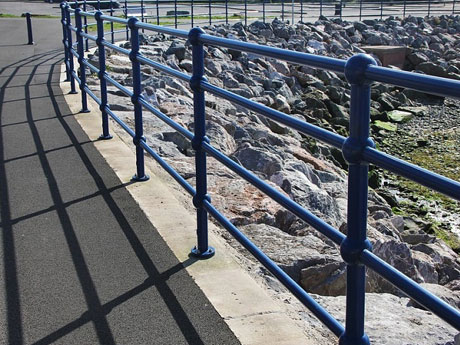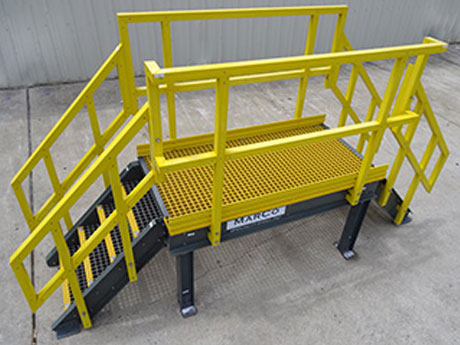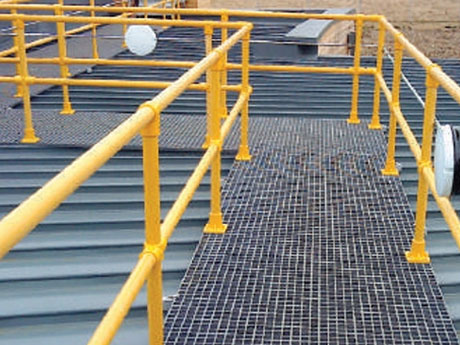Handrails Gratings
Handrails Gratings
A handrails Gratings is a rail that is designed to be grasped by the hand so as to provide safety or support. Handrails Gratings are referred to as banisters. Handrails are commonly used while ascending or descending stairways and other areas where safety is the primary concern in order to prevent injurious falls or to hold necessities. Handrails are typically supported by bold and nuts or attached to walls.
We (EDTF) is one of the finest Handrail Manufacturer in India as per client specification, and it is fabricated by using mild steel pipes, angles, flats and other structural profiles. We provide a complete solution for Handrail Manufacturer & Suppliers in India, which includes base plates, toe plates, bends and connectors. The handrails are supplied in the finish of Self-color, Hot Dip Galvanizing and Painting.
In both residential and commercial settings, handrails play a vital role in ensuring safety and accessibility. These simple yet essential fixtures provide support and stability, especially on staircases and ramps, helping individuals navigate spaces with confidence and ease. In this comprehensive SEO guide, we'll explore the importance of handrails, the different types available, installation methods, and key considerations for optimizing safety and accessibility in your environment.
Importance of Handrails
Handrails are more than just functional components of a building—they are essential safety features that can prevent accidents and injuries. Whether indoors or outdoors, handrails provide a sturdy grip for individuals ascending or descending stairs, ramps, or inclines. They offer stability to people of all ages and abilities, including the elderly, children, and individuals with mobility challenges, ensuring that everyone can navigate spaces safely and independently.
Types of Handrails
Wall-Mounted Handrails: These handrails are attached directly to the wall using brackets or mounts. They are commonly used in indoor settings, such as staircases and hallways, where there is a solid wall for support.
Post-Mounted Handrails: Post-mounted handrails are installed using posts or balusters, providing support along staircases, ramps, or walkways. They are versatile and can be used in both indoor and outdoor environments.
Grab Bars: While technically not handrails, grab bars serve a similar function by providing support and stability in areas such as bathrooms and showers. They are typically installed near toilets, bathtubs, and showers to assist individuals with balance and mobility.
Guardrails: Guardrails are similar to handrails but are primarily used for fall protection and safety along elevated platforms, balconies, and decks. They are taller and sturdier than handrails, providing a barrier to prevent falls.
Installation Methods
Secure Mounting: Whether wall-mounted or post-mounted, handrails should be securely anchored to the supporting structure using sturdy hardware, such as screws or bolts.
Height and Clearance: Handrails should be installed at a comfortable height for users, typically between 34 to 38 inches above the walking surface. There should also be adequate clearance between the handrail and the wall or adjacent surfaces to allow for a firm grip.
Continuous Grip: Handrails should provide a continuous grip along the entire length of the staircase or ramp, with no gaps or obstructions that could impede users' progress.
ADA Compliance: When installing handrails in public or commercial buildings, it's essential to ensure compliance with the Americans with Disabilities Act (ADA) guidelines, which specify requirements for handrail height, diameter, and placement to accommodate individuals with disabilities.
Key Considerations for Safety and Accessibility
Material: Choose durable and low-maintenance materials such as stainless steel, aluminum, or vinyl that can withstand the elements and provide a secure grip.
Design: Select handrails with a comfortable grip and ergonomic design to accommodate users of all ages and abilities.
Visibility: Ensure handrails are easily visible, especially in low-light conditions, by selecting contrasting colors or adding reflective tape or markings.
Maintenance: Regular inspection and maintenance of handrails are essential to identify and address any issues such as loose fittings, corrosion, or damage that could compromise safety.
Product Gallery



